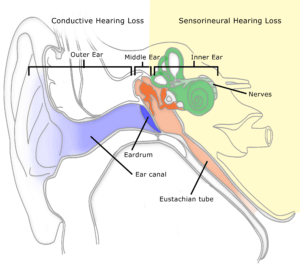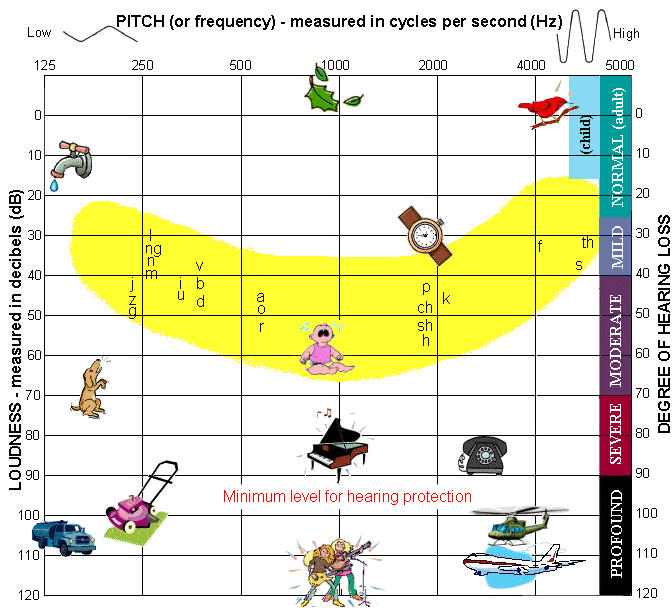Hearing Loss
Hearing loss is a sudden or gradual decrease in how well you can hear. Depending on the cause, it can be mild or severe, temporary or permanent.
Congenital hearing loss means you are born without hearing. This topic focuses on gradual hearing loss, which happens over time and can affect people of all ages.
If you have hearing loss, you may not be aware of it, especially if it has happened over time. Your family members or friends may notice that you’re having trouble understanding what others are saying.
There are ways you can deal with hearing loss. And hearing aids and other devices can help you hear.
Understanding Hearing Loss
Hearing loss is the third most common health related problem in the United States. It is estimated that 28 million Americans have a hearing loss. Of those who have a hearing loss only six million have pursued hearing help and approximately 700,000 of those have a severe to profound hearing loss.
urther, the incidence of hearing loss in newborns is approximately 1 in 1000 making hearing loss the number one congenital condition surpassing Down Syndrome and Spina bifida. Hearing loss can be classified in three different ways:
- based on location of the disease within the ear
- based on the onset of the hearing loss in relationship to speech and language development
- based on the cause of the disease within the ear
In adults, the most common causes of hearing loss are:
Noise:
Noise-induced hearing loss can happen slowly over time. Being exposed to everyday noises, such as listening to very loud music or using a lawn mower, can damage the structures of the inner ear, leading to hearing loss over many years. Sudden, loud noises, such as an explosion, can damage your hearing.
Age:
In age-related hearing loss, changes in the inner ear that happen as you get older cause a slow but steady hearing loss. The loss may be mild or severe, and it is always permanent.
Other causes of hearing loss include earwax buildup, an object in the ear, injury to the ear or head, an ear infection, a ruptured eardrum, and other conditions that affect the middle or inner ear.
Common symptoms of hearing loss include:
- Muffled hearing and a feeling that your ear is plugged.
- Trouble understanding what people are saying, especially when other people are talking or when there is background noise, such as a radio.
- Listening to the TV or radio at a higher volume than in the past.
Other symptoms may include:
- A ringing, roaring, hissing, or buzzing in the ear, called tinnitus.
- Ear pain, itching or irritation of the ear, or fluid leaking from the ear.
- A feeling that you or your surroundings are spinning (vertigo).
Your doctor will do a physical exam and ask about your symptoms and past health. He or she also may look in your ears with a lighted device called an otoscope.
If your doctor thinks that you have hearing loss, he or she will do hearing tests to check whether you have hearing loss and find out how severe it is. You may be referred to an audiologist to do the tests.
These tests may include:
- A tuning fork test, which helps your doctor know which kind of hearing loss you have.
- Other tests to find out what kind of hearing loss you have or which part of your ear is affected.
Hearing Loss is based on the location of the disease within the ear

There are three different types of hearing loss depending on the location of the disease within the ear. A conductive hearing loss results when a problem originates with the outer ear or middle ear and prevents or impedes sound from being conducted to the inner ear. A conductive hearing loss can stem from an abnormality of development, such as the absence or incomplete formation of a part of the external or middle ear system. The problem can also be caused by disease within the external ear or the middle ear such as severe and continuous otitis media (inflammation of the middle ear often accompanied by fluid buildup). This type of hearing loss can generally be corrected by medical or surgical means so that hearing is restored. A sensorineural hearing loss results from an abnormality of development or disease affecting the cochlea or auditory nerve. The cochlea is the organ that converts sound waves to electrical energy. The auditory nerve transmits the sound stimuli in the form of electrical impulses to the auditory center of the brain. In general, sensorineural hearing loss cannot be treated by current medical or surgical techniques because there is permanent damage to the inner or auditory nerve. A mixed hearing loss involves both a sensorineural and conductive component. The conductive part of a mixed loss may be treated by medical or surgical means, depending on the type of disease present and the percentage of the total hearing loss it may represent.
Degrees of Hearing Loss

Mild*- will have trouble hearing soft or distant speech
Moderate – will have trouble hearing speech at normal conversation level
Severe – will have trouble hearing loud speech
Profound – will have trouble hearing environmental sounds
*Even mild hearing loss can impact speech and language skills
Treatment depends on the type and source of hearing loss. Surgery may reverse hearing loss caused by otosclerosis, scar tissue, or infection while Ménière’s disease is sometimes treatable with medication and diet modification.
Hearing loss caused by infection can often be treated with antibiotics.
If you think your hearing loss stems from medication use, talk with your doctor about alternative drug options. Prompt medical treatment for sudden hearing loss may increase the chance of recovery.
People with permanent hearing loss need to learn how to function with the hearing they still have. Most people with permanent hearing loss can benefit from using a hearing aid — yet only one in five eligible people use them. Hearing aids are tiny instruments you typically wear in or behind your ear that make sounds louder. Things do sound different through a hearing aid, so it’s important to talk with your doctor to set realistic goals.
Other sound-enhancing technologies include personal listening systems that allow you to tune in to what you want to hear and mute other sounds. TV-listening systems make it possible for you to hear the television or radio without turning the volume way up. Different kinds of phone-amplifying devices are available to make conversations possible on home and mobile phones. Finally cochlear implants are used mainly with young children but are becoming more popular among older adults with profound hearing loss.

- Auditory Brainstem Response (ABR)
- Otoacoustic Emissions (OAEs)
- Tympanometry
- Acoustic reflex testing
- Behavioral testing
- Behavioral observation audiometry (BOA)
- Visual Reinforcement audiometry (VRA)
- Conditioned play audiometry (CPA)
- Conventional audiometry
- Avoid loud noise, such as noise from machines at your work, power tools, very loud music, and very loud
motorcycles. - Turn down the volume on anything that you listen to through ear buds or headphones, such as MP3
players. - Wear hearing protection, such as earplugs or earmuffs.
- Avoid putting objects in your ear.
You can work with your family and friends to re-establish two-way communication. For starters, set up your home so your rooms are well lit and the chairs face each other. Seeing the faces of people when they talk allows you to see their mouths move as well as their facial expressions. Remove avoidable sources of background noise; for instance, turn off the TV when no one’s watching it. Then let people know a few things they can do to help you understand them better:
- Make sure they have your attention before they start talking.
- Make sure you can see their lips moving when they talk.
- Speak clearly but don’t shout.
With so many untreatable cases of hearing loss, prevention is your best ticket to healthy long-term hearing.
Wear earplugs when you’re exposed to sounds as loud or louder than traffic. Lawn mowers, power sanders, vacuums, and most concerts are all loud enough to harm unprotected ears. When possible, move away from the source of the noise. For example, cross the street or cover your ears when you walk past a loud road construction site.
If you work in a noisy workplace, talk to your employer about ear safety. The National Institute for Occupational Safety and Health (NIOSH) recommends that employers in noisy plants install barrier walls or mufflers to protect their workers’ hearing. Hearing loss is often permanent, so do what you can to protect one of your most valuable natural assets.



